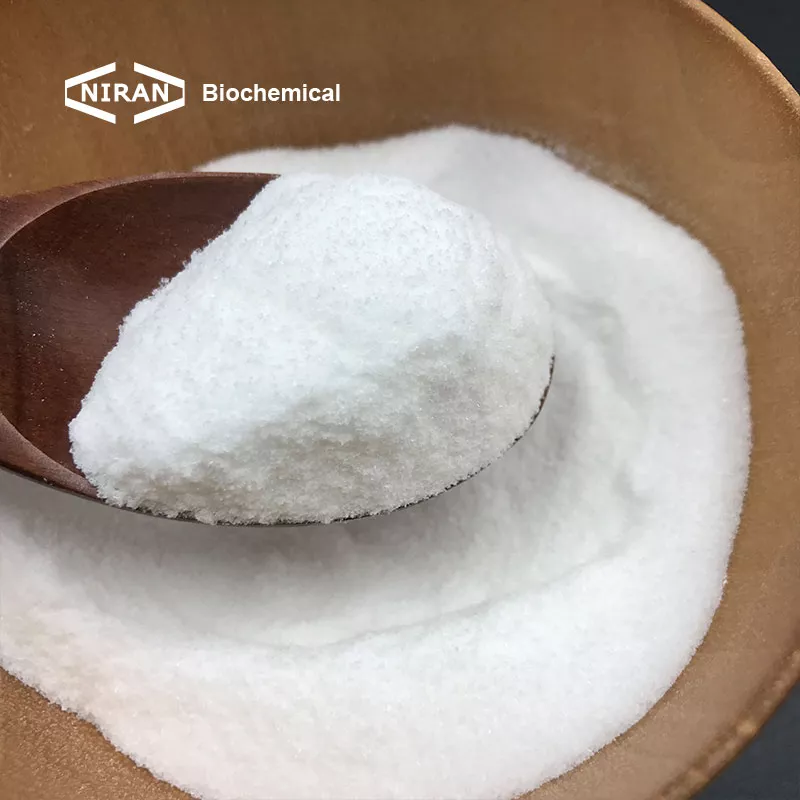Beyond its nutritional role, ascorbic acid is a workhorse antioxidant, color protector, and pH adjuster that helps manufacturers stabilize products, extend shelf life, and meet label claims. This guide follows the same section flow as the Niran Chemical “Ultimate Guide” you shared, adapted specifically for ascorbic acid.
Properties
| Property | Value |
| Chemical name (L-ascorbic acid) | C₆H₈O₆ |
| Molar mass | 176.12 g/mol |
| Appearance | White to slightly yellow crystals/powder |
| Decomposition temperature (no clear boil) | ~190–192 °C (decomposes) |
| Density (25 °C) | ~1.65 g/cm³ |
| Water solubility (20 °C) | ~33 g/100 mL (≈330 g/L) |
| pH (1–5% aq.) | ~2.2–2.5 |
| pKa (acid dissociation) | ~4.1 (pKa1), ~11.6 (pKa2) |
| E-number (food additive) | E300 |
| LogP (octanol/water) | ~−2.15 (very hydrophilic) |
Physical Forms & Grades
Ascorbic acid is supplied in multiple particle sizes and grades to match different processes.
Common forms
- Crystalline powder (USP/FCC, EP, BP): the standard for most foods, supplements, and pharma. Typical assay 99.0–100.5%.
- Granular / mesh-controlled (e.g., 20–80 mesh): improved flow and less dust for premixes and tablets.
- Direct-compression (DC) / agglomerated: optimized for tablet presses without wet granulation. (Specs mirror USP/FCC assay.)
- Coated / encapsulated: slows oxidation, reduces hygroscopicity, improves stability in moisture/heat-sensitive matrices (e.g., bakery, cereals). (Vendors supply coated vitamin C variants.)
Related ingredients (often used alongside or instead of L-ascorbic acid)
Sodium ascorbate (E301) and calcium ascorbate (E302)—buffered salts, higher pH impact; widely permitted as antioxidants.
Ascorbyl palmitate (E304)—fat-soluble antioxidant for oils and emulsions. (Covered by EFSA under antioxidant additives.)

How Ascorbic Acid Is Made
Industrial production is dominated by two routes starting from glucose (typically from corn or other starch sources):
The Reichstein Process (classical route)
A hybrid chemical–biotechnological sequence: D-glucose → D-sorbitol (hydrogenation) → L-sorbose (microbial oxidation) → 2-keto-L-gulonic acid (2-KLG) → cyclization to L-ascorbic acid. Although robust and scalable, it uses multiple steps and reagents and is being supplanted by modern fermentation.
Two-Step Fermentation (modern route)
Successive microbial fermentations convert D-sorbitol to L-sorbose, then to 2-KLG, followed by chemical lactonization to ascorbic acid. This route reduces chemical steps, improves yields, and is the preferred industrial method today. Published reports cite step yields near the high-90% range under optimized conditions.
Emerging research explores direct microbial production of ascorbic acid using engineered strains to simplify the pathway and reduce costs and waste—areas of active development.
Applications
Food & Beverage (E300)
- Antioxidant/color protection. Prevents enzymatic browning in cut fruits, juices, and potato products; protects flavors and colors in beverages and jams.
- Fortification. Widely used to deliver labeled vitamin C content in juices, plant-based drinks, confectionery, and infant foods.
- Dough improver. Strengthens gluten network in bread-making; improves gas retention and loaf volume.
- Meat processing. Ascorbate accelerates nitrite curing reactions and helps control nitrosamine formation.
- Regulatory bodies in the EU and U.S. permit its use as an antioxidant and nutrient with defined purity specifications and good manufacturing practice limits.
Dietary Supplements & Clinical Nutrition
Tablets, powders, effervescents, gummies, shots. Ascorbic acid and buffered salts exhibit equivalent bioavailability to food-derived vitamin C in most healthy adults, simplifying formulation choices.
Pharmaceuticals
Active and excipient roles. Treats and prevents scurvy; serves as an antioxidant excipient in aqueous formulations to protect actives from oxidation. (Follow pharmacopeial monographs for identity/purity.)
Cosmetics & Personal Care
Skin-care antioxidant. L-ascorbic acid supports collagen synthesis and brightening but is stability-sensitive in water; derivatives (e.g., ascorbyl palmitate, magnesium/sodium ascorbyl phosphate) improve stability or oil compatibility.
Animal Nutrition (Feed)
Stability-enhanced feed grade supports immunity, growth, and stress tolerance (e.g., aquaculture). EU authorizations recognize efficacy of ascorbic forms for feed use.
Industrial & Technical
Dechlorination / reducing agent. Quenches residual chlorine in water and processes; oxygen scavenger in packaging headspace; niche uses in photographic and plating baths. (Refer to local regulations for technical vs food-contact applications.)

Safety & Handling
Regulatory Status
Food additive (EU): E300 (ascorbic acid), E301 (sodium ascorbate), E302 (calcium ascorbate) evaluated with no safety concern at reported uses; no numerical ADI required.
U.S. FDA: Considered GRAS for uses consistent with GMP under 21 CFR 182.3013.
Personal Protective Equipment (PPE)
Although not corrosive like strong acids or bases, fine powders can irritate eyes/respiratory tract. Use safety glasses, dust mask/respirator where airborne dust may form, and gloves when handling bulk. Follow site safety policies and SDS guidance from your supplier. (Consult pharmacopoeial/SDS references for detailed exposure limits.)
Storage
Keep dry, cool (typically ≤25 °C), and tightly sealed. Protect from light, moisture, air, and metal contamination; consider nitrogen-flushed or desiccated storage for opened containers. Coated grades offer improved shelf life in premixes and baked goods.
Mixing & Dilution
Dissolves readily in water; to minimize oxidation, prepare solutions shortly before use, keep pH acidic (e.g., pH < 4), and avoid prolonged exposure to air or elevated temperatures. Use non-reactive equipment (plastic or stainless steel with proper finish).
First Aid (General Guidance)
- Inhalation: Get to fresh air and consult a doctor if irritation continues.
- Eye contact: Flush eyes with water for several minutes, remove contacts if easily possible, then continue rinsing.
- Ingestion/skin: Typically low acute toxicity; rinse mouth/skin and seek advice if symptoms occur. Always follow your SDS for jurisdiction-specific guidance.
Note on intake limits. For nutrition use, consult health-professional sources for RDA and upper limits; high-dose supplementation (e.g., ≥2,000 mg/day in adults) can cause GI upset and may elevate kidney stone risk in susceptible individuals.
Environmental Impacts & Sustainability
Compared with many industrial chemicals, ascorbic acid itself is readily biodegradable and exhibits low environmental hazard at typical use levels.
The larger sustainability levers lie in manufacturing efficiency (fermentation yields, solvent usage, energy) and supply chain (glucose source, regional concentration of production capacity).
Ongoing process innovations—including engineered microbial routes—aim to reduce waste and energy intensity while improving yield and robustness.
Why Does Ascorbic Acid Pricing Fluctuate?
Unlike commodities tied to extraction, ascorbic acid pricing reflects bioprocess capacity, feedstock costs, and regulatory/market dynamics:
- Feedstock & utilities: Glucose/starch pricing, energy costs for fermentation, hydrogenation, drying, and milling.
- Process efficiency: Strain performance, yields, solvent recovery, and downtime.
- Quality tier: USP/EP/FCC/food vs feed; coated vs uncoated; particle engineering adds cost.
- Geographic concentration: A significant share of global capacity is in East Asia; logistics, FX, and trade policy can amplify price swings.
- Demand cycles: Seasonality in beverage fortification, premix production, and supplement markets can tighten spot availability.
Public market briefs and industry reports frequently attribute price movement to these levers; for current quotations, request COA-backed offers from multiple suppliers. (Avoid relying on outdated spot prices.)
Where to Buy Ascorbic Acid at Competitive Prices
Direct from manufacturers (especially where fermentation capacity is concentrated) often yields the best unit economics at volume. Global distributors provide multi-origin sourcing, smaller MOQs, and logistics support. Group purchasing arrangements can help small and mid-sized buyers.
For food/pharma applications, require: current GMP certification, ISO 9001/22000, pharmacopoeial compliance (USP/EP/BP/FCC where applicable), and batch COA including assay, heavy metals, oxalate, sulfated ash, loss on drying, particle size, and microbiology.
Typical Specifications Snapshot (Illustrative)
| Test | Typical Spec (Food/Pharma Grade)* |
| Assay (as C₆H₈O₆) | 99.0–100.5% (titration/HPLC) |
| Identification | IR/UV per pharmacopeia |
| Loss on drying | ≤0.4% |
| Residue on ignition (sulfated ash) | ≤0.1% |
| pH (2% solution) | ~2.2–2.5 |
| Heavy metals (Pb) | Meets current pharmacopeial limits |
| Mesh / PSD | As ordered (e.g., 20–80 mesh) |
Packaging, Shelf Life, and Handling at the Plant
- Packaging: Commonly 25 kg cartons/drums with double polyethylene liners; smaller packs for labs and supplements.
- Shelf life: Often 24–36 months unopened under recommended conditions; shortened in warm/humid climates or after opening.
- Good practice: Use FIFO, keep partially used bags nitrogen-flushed or well-resealed with desiccants, and track potency in solution-phase applications with routine QA checks.
Quality & Compliance Checklist
Regulatory fit
Food use: E300 in the EU; GRAS in the U.S. for intended uses.
Compendial fit
If labeling USP/EP/FCC, ensure batch tests and methods match the monograph.
Allergen/GMO statements
Request documentation (common for corn-derived feedstocks).
Stability data
Ask for real-time/accelerated stability, especially for coated grades and premixes.
Supply assurance
Multi-origin sourcing or safety stock for seasonal demand spikes.
Ascorbic acid is a rare “triple-threat” ingredient: nutritive, functional, and technically versatile. Understanding its chemistry (acidic, easily oxidized in solution), the production routes (Reichstein vs. modern fermentation), and the regulatory framework (E300 / GRAS) helps you source wisely and formulate for performance.
For commercial use, align on grade, coating/particle size, specification compliance, and stability strategy—and you’ll get both nutritional value and process efficiency from one dependable molecule.
